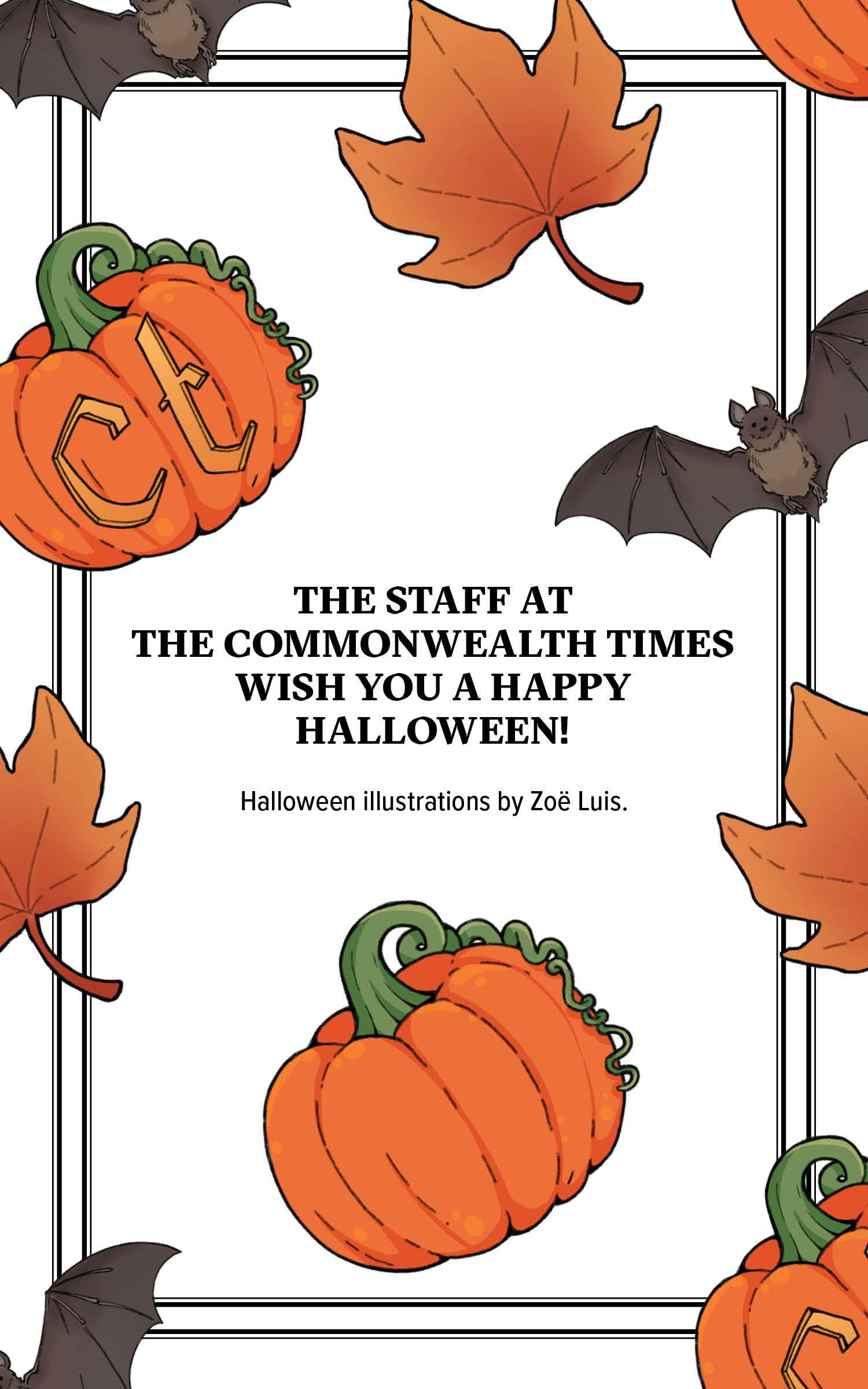Democrats scramble to redraw Virginia voting maps amid Trump threats
ANDREW KERLEY Executive Editor
Democrats called the Virginia General Assembly back on Monday for a special session to redraw the state’s congressional districts and give themselves an upper edge in winning more seats in the United States House of Representatives.
The effort mirrors those by legislators in California to offset additional seats Republicans may gain in the House as President Donald Trump pressures Texas and other Republican-leaning states to redistrict.
Democrats will have to work through numerous votes and legal technicalities to successfully redistrict in Virginia ahead of the 2026 midterm congressional elections, which they are currently favored to win a majority in.
Virginia has 11 congressional seats. Six are held by Democrats and five are held by Republicans, but nearly all of them could be turned blue if efforts are successful.
WHAT IS ‘GERRYMANDERING’?
Gerrymandering is the process of legislators redrawing maps to give their respective parties the upper hand. They do so by either redistributing voters they do not favor between multiple split districts, or packing other voters into one safe district. Both major parties have been guilty of the practice.
Virginia has a history of gerrymandering dating back to the post-Civil War Reconstruction Era, when lawmakers used the practice to keep Black voters from gaining representation in Congress.
The practice was effectively outlawed in 2020 when lawmakers amended the Virginia constitution to leave [...]
See REDISTRICTING on page 2



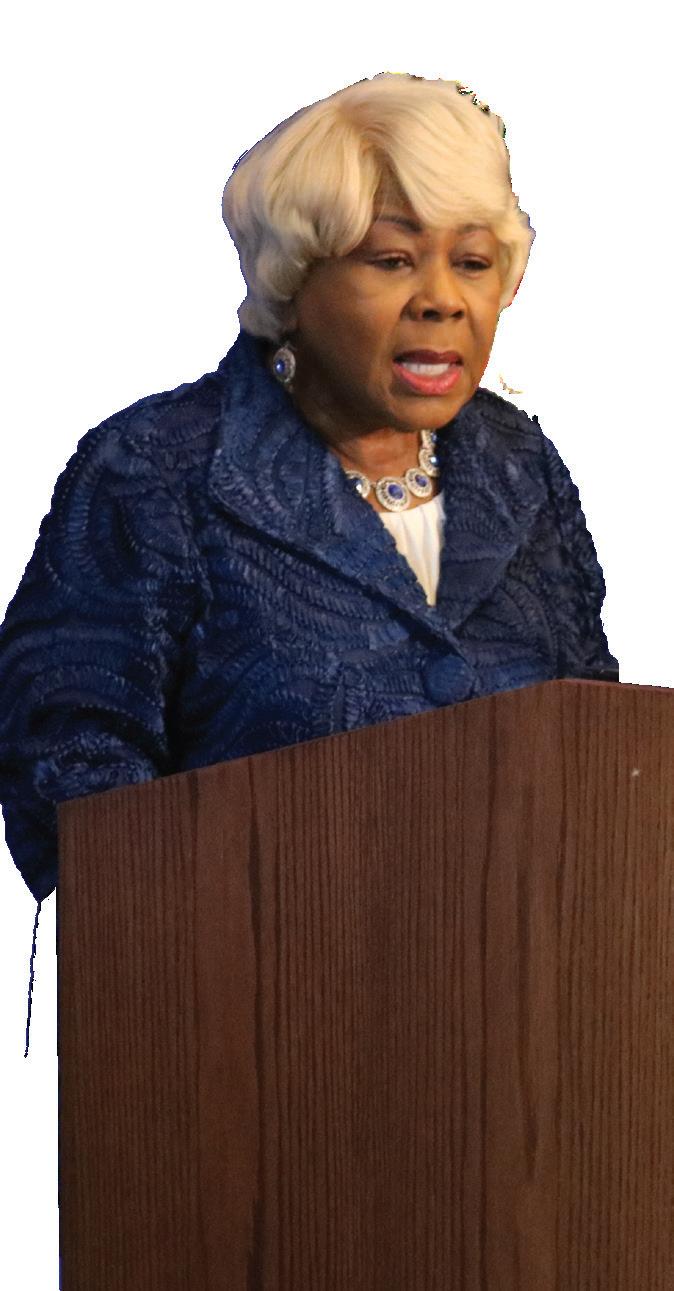

Laziness is ruining Halloween
MOLLY CHRISTIANSON
Contributing Writer
Corsets are ruining Halloween costumes. There, I finally said it. I hate costumes that are just corsets with tiny skirts and stupid headbands. If I just described your costume, I am sure you look cute — however, it is a horrible Halloween costume.
See LAZY COSTUMES on page 13


ORLANDO
Next Tuesday, Nov. 4, is Virginia’s statewide election. Voters will be able to decide the state’s next governor, lieutenant governor, attorney general and House of Delegates members.
Virginians must register to vote before casting a ballot. The deadline to register has passed, but voters can still register and vote up to Election Day using a provisional ballot. Virginians do not register by party.
Polls will be open on election day from 6 a.m. to 7 p.m., and as long as voters are in line by 7 p.m., they can still cast their ballots. The Virginia Department of Elections has information on polling locations based on address.
All voters must provide an acceptable form of identification — if a voter does not have any, they can sign an ID confirmation statement or vote using a provisional ballot. Provisional ballots are offered to voters whose registrations or qualifications are questioned.
Once a provisional ballot is used, a voter must deliver a copy of their identification to their local electoral board, or sign an ID confirmation statement by Nov. 7 at noon for the vote to count.
The Virginia Department of Elections provides a list of acceptable identification,
One week left to vote!
including a current or expired driver’s license, military ID or utility bill.
The deadline to request an absentee ballot was on Oct. 24. Absentee ballots must be returned to local registrar offices by 7 p.m. on election day.
Early voting is available at local registration offices until Nov. 1.
YOUR POLLING PLACE, ACCORDING TO YOUR DORM
On election day, residents living on VCU’s campus at Brandt Hall, the Honors College, Rhoads Hall, West Grace North and West Grace South can vote at the VCU Student Commons.
Students in Ackell Residence Center, Gladding Residence Center and Gladding Residence Center III can cast their ballot at Clark Springs Elementary School in the Randolph neighborhood off of South Harrison Street.
Residents of Grace & Broad will vote at the Institute for Contemporary Art, and those in Broad & Belvidere can vote at George Washington Carver Elementary School off of West Leigh Street.
WHY VOTE?
“The government is based off of our votes,” first-year business student Nathan Poovathukaran said. “We decide our future
by how we vote. Sometimes it feels like voting doesn’t make a difference, but it does — even one vote can change an election.” Poovathukaran casted an early ballot, and said it is important to vote because democracy depends on it.
“I think it’s important to vote because it changes the future of our nation and because it's a healthy way for citizens to voice their concerns and express their opinions,” Poovathukaran said.
Fourth-year elementary education and teaching student Ryan Dutcher will be voting in person on Election Day. Dutcher said they understand how voting can be confusing, given the layout of government websites.
“It is the most direct say that we have in the way that our country runs, the way that our city runs,” Dutcher said. “Especially right now with what’s going on on a national level, it’s incredibly important that we elect state and local representatives that have our best interests at heart.”
Election Day Nov. 4


News
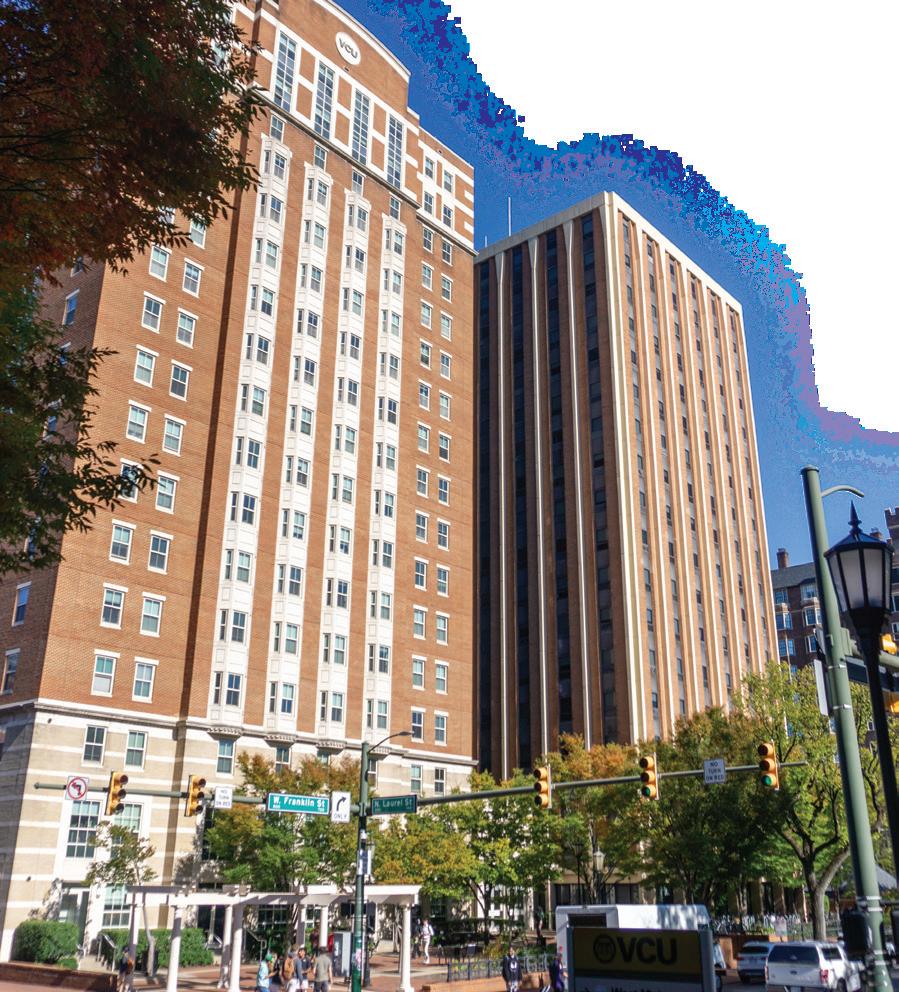

Stories of the week
national: More than two dozen states sued the Trump administration Tuesday as the ongoing federal government shutdown threatens Supplemental Nutrition Assistance Program, or SNAP, benefits.
international: Hurricane Melissa made landfall in Jamaica Tuesday and was recorded as one of the strongest Category 5 storms in history. Jamaica’s Prime Minister Andrew Holness has declared the country a disaster area.


VCU dorm fire alarms went off 91 times last year
Here are which ones went off the most
Contributing Writer
VCU residence halls were evacuated 91 times during the 2024-2025 academic year, mostly due to incidents of vaping and smoking.
Students are instructed to immediately evacuate dorms in the event of a fire alarm, and are often ushered to wait across the street in parking lots or in Monroe Park until first responders clear the building. Wait times can range from 10-30 minutes.
Some students living in residence halls have complained about frequent fire alarms disrup-ting their sleep, classes or work obligations.
Continued from front page
up to a nonpartisan commission — which Virginians overwhelmingly approved through a ballot referendum, according to the Virginia Public Access Project.
The current fight over voting maps began in July when Trump pressured Texas to redraw their districts ahead of the 2026 midterm elections, according to the Associated Press. Other Republicanleaning states have since done the same — spurring Democrats to “fight fire with fire.”
? ? ? ?
REDISTRICTING REQUIRES AMENDING VIRGINIA’S CONSTITUTION
In order to repeal the constitutional amendment that gave sole authority over redistricting to Virginia’s nonpartisan commission ahead of midterms, Democrats will have to pass a new amendment within months. They currently hold majorities in both chambers of the General Assembly, and will have to maintain their numbers in the House of Delegates through the November 2025 election.
An amendment to the Virginia constitution must pass the General Assembly twice between two different sessions before it is left up to voters in a statewide referendum, according to state law.
The General Assembly typically only
The fire alarm in Cary and Belvidere went off 45 times last year, more frequently than any other residence hall, according to data provided by VCU Residential Life and Housing.
The alarm at Gladding Residence Center went off 22 times. It went off at Ackell Residence Center eight times.
The Honors College alarm went off five times. The alarm at Brandt Hall went off four times.
The alarms at Brandt Hall, Broad & Belvidere and West Grace North went off four, three and two times respectively.
Alarms at West Grace South and Grace & Broad 2 both went off one time. No fire alarms went off at Rhoads Hall and Grace & Broad 1.
few instances of people pulling alarms or cooking setting them off, VCU stated.
In the Fall 2025 semester, only upperclassmen dorms have been evacuated so far.

The most frequent causes for fire alarms going off are vaping and smoking, with a
meets at the beginning of the year, and the 2025 session has already passed. Their recent flock to Richmond was based on a technicality — a special session from 2024 that never technically adjourned.
By holding a vote this fall, and then again in the 2026 session, lawmakers could meet the two vote threshold to hold a referendum — which must occur no sooner than 90 days after the amendment is approved by the General Assembly.
If Democrats are successful, a referendum could be held as early as April, just two months before parties will hold primary elections for their 2026 congressional nominees.
Del. Rodney Willet, D-Henrico, is carrying Democrats’ proposed amendment. It will not abolish the Virginia Redistricting Commission, but instead give the General Assembly authority to redistrict only in the event that other states conduct redistricting outside of their standard cycles for any purpose other than complying with a state or federal court order that remedy an unlawfully drawn map — like what Americans are experiencing now.
No proposed maps have been publicized, but in an X post, Senate President Pro Tempore Louise Lucas, D-Portsmouth, mused the creation of a map in which 10 out of Virginia’s 11 congressional districts favor Democrats.
Senate Majority Leader Scott Surovell, D-Fairfax, said during a Senate session on Tuesday that their efforts were less about partisan differences, and more about the future of America.
“I want my kids to experience the same democracy I have,” Surovell said.
The upperclassman dorms are Ackell, Broad & Belvidere, Cary & Belvidere, Grace & Broad, West Grace North and West Grace South.
Cary & Belvidere tops the list again with 15 alarms, followed by Ackell with four alarms, West Grace South had two and one at Broad & Belvidere.
Harper Ballance, a secondyear communication arts student, circulated a collaborative tally of how many times the fire alarm went off at GRC last year, and when they went off.
Ballance counted 14 alarms during quiet
All five of Virginia’s Republican congressional representatives held a press conference on Monday to denounce Democrats’ actions.
Ninth District Rep. Morgan Griffith served as a delegate for nearly two decades before becoming a member of congress. He said Democrats’ efforts to redistrict will undo the will of voters.
“I was a part of partisan redistricting, and the voters of Virginia spoke in 2020 that they didn’t like that happening,” Griffith said.
Sixth District Rep. Ben Cline said what Democratic congressional leaders Rep. Hakeem Jeffries, D-NY, and Sen. Chuck Schumer, D-NY, are doing to Virginia is “scandalous.”
“It’s my hope the voters of Virginia will reach out to their legislators, let them know they don’t want gerrymandering back in Virginia,” Cline said. “They don’t want politics to rule when it comes to redrawing our district lines.”
? ? ? ?
AMERICA INCHES TOWARD ALLOUT REDISTRICTING BATTLE
Texas, Missouri, North Carolina and Utah are among states where legislators have taken serious steps to redistrict to increase Republicans’ favor, per Trump’s requests. Virginia is the only Democraticleaning state to have taken up similar measures after California — though other states are considering doing the same.
Just before Virginia Scope initially
hours and found the average time the alarm went off was 3:05 a.m..
“A large amount of them went off in the middle of the night, waking me up,” Ballance stated. “I was often left tired in the mornings, which affected how well I could perform in my classes that day. The alarms are very sensitive and it makes sense why, but it was still very annoying to see how small some of these incidents actually were.”
Susanna Menendez, a second-year psychology and health services student who lived in the Honors College, stated the fire alarm went off frequently, often because of construction being done on the elevators.
“It was very inconvenient for the majority of us since we live on floors three through seven,” Menendez stated. “Sometimes I went to work without certain materials or not dressed profess-ionally due to not being able to enter my building.”
reported rumors of the special session, the National Democratic Redistricting Committee donated $150,000 each to the House Democratic Caucus and Abigail Spanberger’s campaign for governor, according to VPAP.
VCU associate political science professor John Aughenbaugh said redistricting is a “double edged sword” for Democrats, because even if they pass a resolution twice, the referendum to create the nonpartisan commission was popular with Virginians in 2020.
“It is risky, but if you think the greater enemy is President Trump and him having a majority in the House of Representatives, and this is their thinking, Donald Trump and the Republican Party is a greater enemy to Democracy than hyperpartisan gerrymandering in response,” Aughenbaugh said.
Redistricting battles across state lines could lead Americans to an end point of hyperpartisan map drawings that deprive minority voters of representation in Congress, according to Aughenbaugh. States like New York have plenty of Republicans, and states like North Carolina have plenty of Democrats, but those numbers are not reflected by their congressional representatives.
Some Republican states are preparing to redraw their district lines on the chance the Supreme Court repeals section two of the 1965 Voting Rights Act, which prohibits voting practices or procedures that discriminate on the basis of race, color or membership.
“This is Democracy backwards,” Augenbaugh said. “Voters should be picking their candidates, instead of parties and their candidates picking their voters.”
Students, city councilor grapple with VCU’s role in Richmond housing shortage
HECIEL NIEVES BONILLA Assistant News Editor
VCU students, faculty and staff met with Richmond City Councilor Katherine Jordan and other community members at an event on Wednesday to discuss growth, affordability and how VCU’s student housing needs fit into Richmond’s greater development plans.
The “Democracy in Dialogue” forum was held by political science associate professor Amanda Wintersiek, director of the Institute for Democratic Empowerment and Pluralism, and Doug Sprei, director of the College Debate and Discourse Alliance. Students delved into contradictions between VCU’s growing student body, lack of affordable housing and its investments in new construction — while other speakers emphasized the need for students to engage in civic life and advocate for their position in the city’s development.
STUDENTS AND RICHMONDERS SHARE HOUSING STRUGGLES
Since the closure of Johnson Hall due to a mold infestation in 2021, VCU has reworked its housing offerings in order to fit all students who want to live on campus. Some residential units originally meant to house two students now house four students. VCU has also continuously bought swaths of property between its Monroe Park and MCV campuses, as outlined in the ONE VCU Master Plan.
Richmonders do not see themselves reflected in the university’s branding despite VCU’s large physical footprint in the city, one attendee, third-year political science student Emma Coffey, said. They feel they have been wronged by the school, according to Coffey, who noted the responsibility of engaging with the city also falls on students.
“You shouldn’t have students isolating themselves either…” Coffey said. “They’re engaged with the Black and Gold, but they’re not actually engaged with Richmond itself. They couldn’t tell me what the symbol is on the Richmond flag.”
Much of the event’s conversation revolved around the Richmond 300 Plan, which seeks to guide Richmond’s physical changes as its population nears 300,000 residents, and ensure the needs of existing residents, cheaper rent and better city services, are kept up with.
The city’s main tool to achieve this is changing its zoning code to redefine what kinds of buildings it allows developers to build, and in which areas, to allow for taller and closer construction.
Coffey is from the area and has not lived in VCU student housing, largely because of affordability.
“I’m barely affording tuition, I’m barely affording a parking pass every semester, how am I gonna afford VCU or even off-campus housing?” Coffey said.
PRIORITIZING STUDENT HOUSING
Jackson Mallory is a criminal justice and political science student, as well as a research fellow with IDEP. He supports Richmond’s zoning plan, and said densifying Broad Street and other areas to allow for taller apartment complexes could aid Richmonders being priced out.
Mallory does not think the student housing problem is from a lack of funds on VCU’s part, and gave the example of the funds converting the Founder’s Hall at Residential Life and Housing — not into dorms, but office space.
“The issue is where their values lie,” Mallory said. “It’s not about the money they’ve received, they’ve received plenty of money from 29,000 students that go there. They keep raising our tuition, and keep raising Michael Rao’s salary.”
Athletic village will be done on time, director says at signing ceremony
MARCUS LEARY
Contributing
Writer
A deal on Richmond’s new Diamond District is nearly complete, a redevelopment plan for 67 acres of underutilized land that the city is turning into a hub for sports and entertainment.
The City of Richmond, VCU and Navigators Baseball, the ownership group for the Richmond Flying Squirrels, came together to display their continued collaboration in a ceremonial signing on Oct. 22 at Sports Backers Stadium.
It will include CarMax Park, the new home for the Flying Squirrels and VCU baseball, and the VCU’s new Athletic Village — as well as shops, restaurant space and hotels.

Most of the room concurred with Mallory’s latter comment.
Jordan is the city councilmember for Richmond’s second district, which encompasses much of campus and the inner Fan neighborhood north of Main Street. She stressed the responsibility to accommodate students falls mostly on the school.
While Jordan said she is unfamiliar with the specifics of the university’s governance, she questions the VCU’s seeming priority of other projects over housing construction and maintenance.
“VCU is constantly buying up property within the city … What I call demolition by neglect, they buy properties thinking they’ll do something with it in the future, let it fall down, it’s dangerous and now we have to demolish it,” Jordan said.
Multiple students at the event spoke to the quality of certain residence halls as an issue — in particular, the students who have to sleep in rooms modeled out of former common areas at Gladding Residence Center, and in smaller rooms at Rhoads Hall, according to a previous report by The CT.
Councilor Jordan shared her own experience of living in a converted janitor’s closet during her first year at the University of Virginia, and implored students to speak up at Board of Visitors meetings or to the school paper.
VCU’S UNTAXABLE LAND LEAVES RICHMOND LOW ON CASH
Discussion shifted to the large amount of untaxable, publicly owned land within Richmond’s city limits, including VCU. Property taxes are a large part of how the city pays for services, which are key to supporting a growing population.
Jordan told The CT she believes the school’s PILOT, or payment in lieu of taxes, to the city does not do enough to make up for its footprint. She does support Richmond’s broader efforts to enable affordable housing construction in spite of limitations.
“I think this is an all-hands-on-deck situation where the city is trying to take on the rezoning to streamline the building process in general, and encourage the increased development of housing where it’s most appropriate,” Jordan said. “But equally we need our partners at the university to step up and help provide housing for their students as well.” Jordan said.
Veranda Cobbs, a manager for VCU’s Division of Community Engagement, said the school does address its relationship with the city, and she personally talks with different neighborhoods about communication between them and VCU’s students and faculty.
She stressed the importance of students talking with other Richmonders and getting involved themselves to discuss issues such as housing.
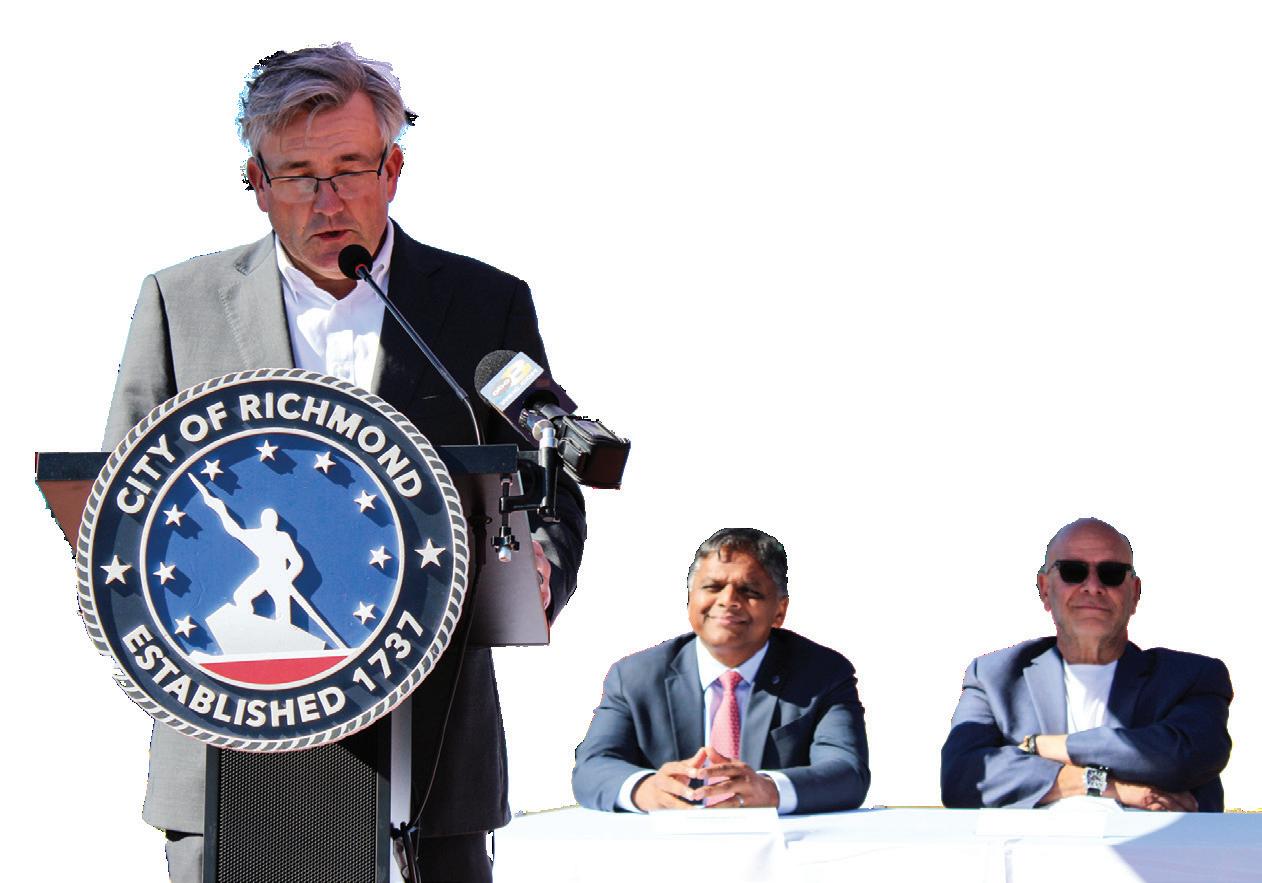
While details still need to be worked out, and the overall operating agreements have not been signed, plans to move forward are underway.
Most speakers spent their allotted three minutes recognizing the work all parties have put in to make the Diamond District a reality. Mayor Danny Avula described the event as a “momentous day” for Richmond.
Odie Donald II, Avula’s Chief Administrative Officer for the City of Richmond, said he believes public-private partnerships like the Diamond District build a more connected community.
“The Diamond District is poised to be a place where families gather, students thrive and local businesses grow,” Donald said.
Construction was slowed down by
VCU’s sale of Sports Backers Stadium to the city. The two parties came to an agreement in early October, according to the Richmond Times-Dispatch. However, the deal won’t be finalized until VCU’s Board of Visitors approves of the terms.
Angie Rodgers, executive director of the Richmond Economic Development Authority, said she expects Sports Backers Stadium to be torn down between January and March of 2026.
Construction of the Athletic Village started in the fall of 2024, with the expected completion being before spring sports began in 2026.
Despite fears that the project’s end would have to be pushed back, VCU director of athletics Ed McLaughlin said
Students can provide their input at the VCU Division of Community Engagement’s CONNECT Conference on Nov. 14 at the Student Commons.
he is confident they will still finish around the agreed-upon time.
With the Athletic Village and CarMax Park being key components of the Diamond District, McLaughlin believes the project will improve the studentathlete experience.
“Right now, our guys don’t have their own clubhouse,” McLaughlin said. “So we have to take stuff back and forth to the Siegel Center, where our locker room is. Now we’ll have our own clubhouse and we’ll have our own coaches’ offices. We’ll have a home here.” McLaughlin confirmed that VCU’s teams could move into CarMax Park as soon as the Flying Squirrels do, with the stadium’s inaugural game on April 7, 2026, according to Minor League Baseball.
Sports
Men’s basketball hunts down the Stags in home exhibition
DREW THOMPSON Sports Editor
YENNI JIMENEZ ACOSTA Contributing Writer
VCU’s new men’s basketball team formally introduced themselves at the Siegel Center with a 82-64 win over Fairfield University on Sunday in the final exhibition match before the season opener.
The Rams won the tip and third-year forward Lazar Djokovic immediately opened the scoring with a layup.
First-year guard Nyk Lewis notched his first points in the Stu with a three, and redshirt fourth-year guard Jadrian Tracey followed it up with another three.
VCU created opportunities on nearly every offensive possession, but looked sloppy defensively. Fairfield dominated on the boards and got fouled often to keep the game within three points in the opening five minutes.
The Rams started to pull away with a timely 9-0 run halfway through the first period, capped off with a block from fourth-year forward Christian Fermin into a transition layup for third-year forward Michael Belle.
“It felt great to be back in the Siegel Center,” Belle said. “I just hope we continue to grow as a team and keep getting better; keep getting sharper.”
The offense dried up as both teams experienced a three minute scoring drought with eight minutes left in the first half.
VCU’s sloppiness on the boards translated to its offense as it found itself in turnover trouble, with four turnovers in four minutes.
Djokovic ended VCU’s drought with a layup; soon after, Fairfield scored a midrange jumper.
The Rams’ offense kept them ahead of the Stags despite their lack of rebounding and foul trouble. VCU hit double-digit fouls with less than a minute remaining in the first, but its offense propelled it into a 39-26 lead at halftime.
The Rams made 57% of their shots from the field compared to the Stags’ 25%, however Fairfield stayed in the game with
an additional eight shots and domination on the offensive boards.
VCU started the second half from the free throw line after missing two threepointers. Fairfield came back aggressively as it obtained its third team foul in the opening minutes.
Second-year guard Brandon Jennings scored VCU’s first five points with a layup and three free throws.
Third-year guard Tyrell Ward made a free throw, pushing VCU’s lead to 45-36. However, Fairfield embarked on a two minute 7-1 run to make it a five point game.
Second-year guard Terrence Hill Jr. helped the Rams push away with a three point jumper to stop the run, but Fairfield answered back immediately.
Fairfield’s plays got sharper as firstyear forward Brandon Benjamin made a layup and a free throw to keep the five point difference.
Ward made a three point jumper for the Rams to widen the gap and start a 7-0 run halfway through the second period.
“[Ward’s] a great player,” Jennings said. “I think he had a great night out there. He made some shots; he got out in transition. That’s what we need from him.”
Third-year forward Keyshawn Mitchell pushed the gap to 14 points for the Rams with a three pointer.
Fairfield refused to go down easily as it responded with two free throws and a second chance layup by Benjamin, which brought the score back to 10. The Rams offensive consistency kept them in the driver seat as they made four consecutive field goals to maintain the lead.
VCU kept trying to open up the gap
Stat of the week
VCU field hockey third-year Josefina Ventimiglia scored her first goal of the season in the 1-0 win over La Salle University.
VCU showed the growing pains expected from a new roster, but individual flashes of brilliance revealed the team’s latent potential throughout the game.
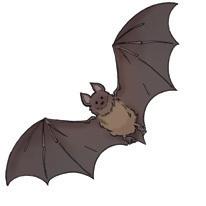
Ward led in scoring 18 points and Tracey stuffed the stat sheet with 11 points, nine rebounds and five assists. Both teams had 40 rebounds, however half of Fairfield’s came on the offensive end.
“20 offensive rebounds to a team that’s smaller is atrocious,” head coach Phil Martelli Jr. said.


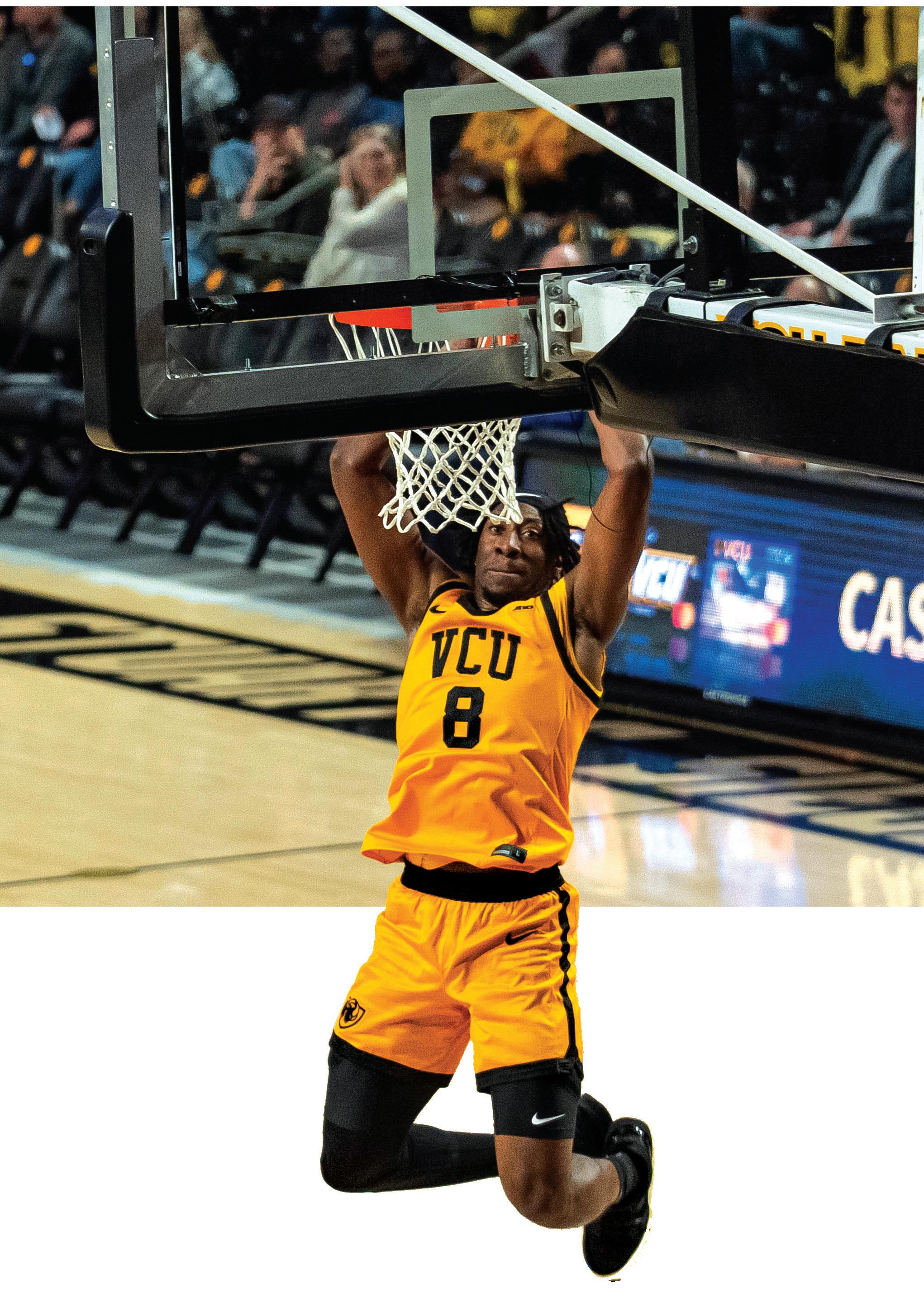
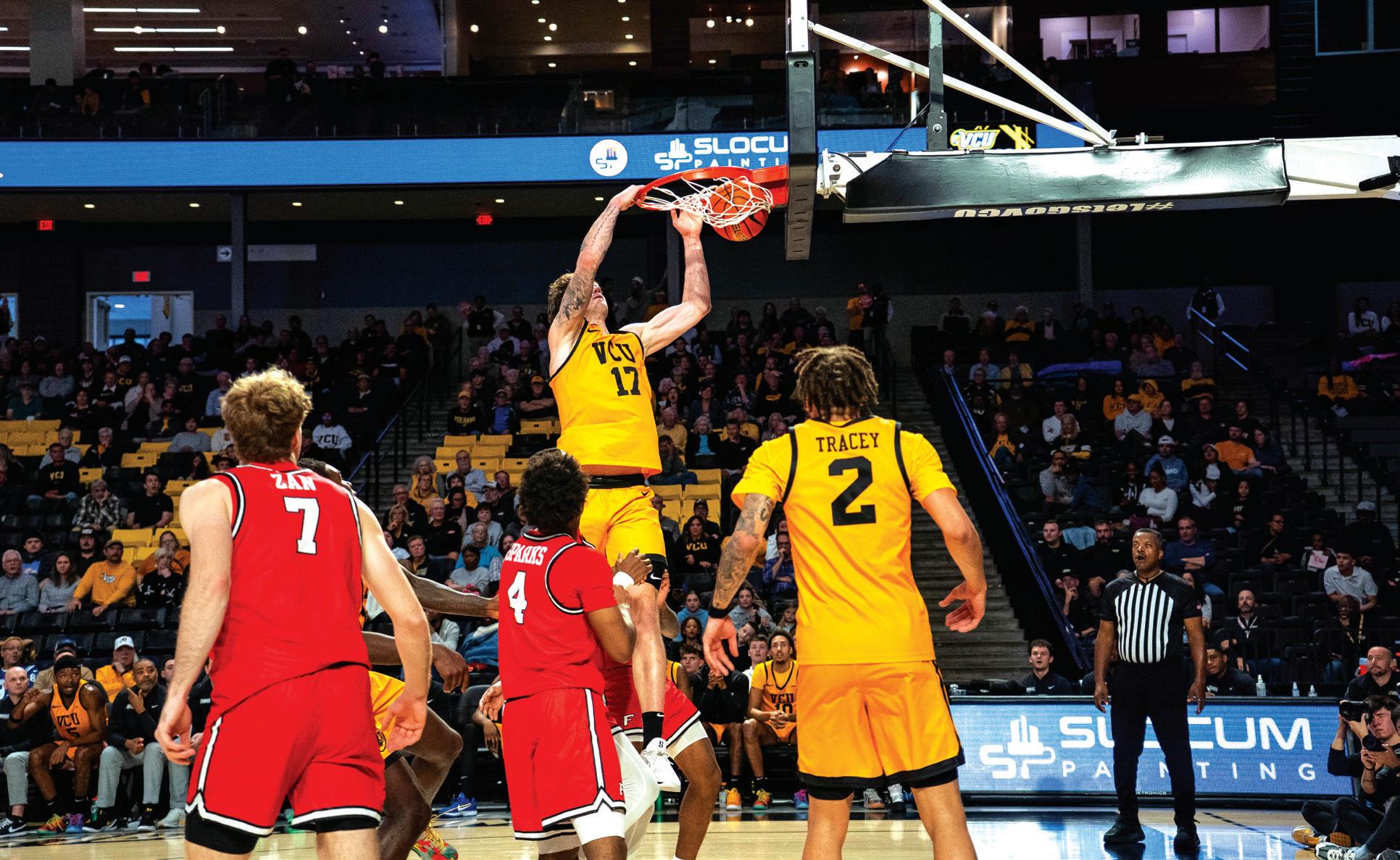
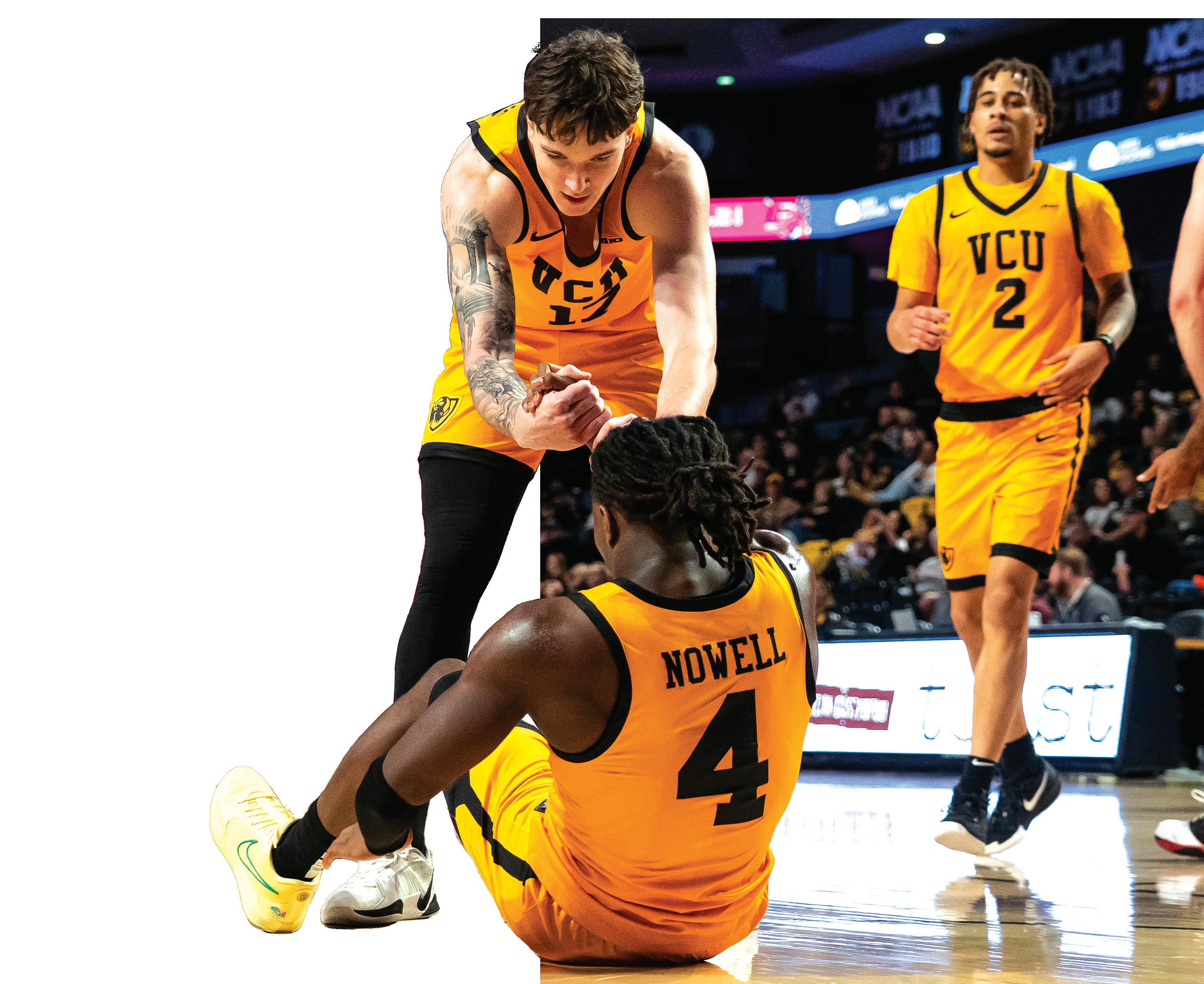
VCU, JMU athletic directors speak on NIL money and revenue sharing
HAYDEN BRAUN
Contributing Writer
The college sports world has completely changed since name, image and likeness, or the NIL , was introduced. VCU and James Madison University are two of the many colleges and universities affected.
Guest speakers Ed McLaughlin, VCU’s athletics director, and Matt Roan, JMU’s athletics director, explored how Virginia colleges are adapting to the realities of NIL rights and revenue sharing in college athletics at a panel hosted by The Richmonder.
McLaughlin reflected on how much the industry has changed, admitting he never imagined his day-to-day life would include conversations with agents.
The previous era of college athletics has passed, but McLaughlin noted there are limitations on NIL money — and not every athletic group gets a fair share.
“There is a cap of what you can directly share with student-athletes in your athletic department,” McLaughlin said.
At JMU, Roan emphasized the pace of change and the need for agility. Networks of Virginia’s athletic directors have begun collaborating regularly to navigate what he called “constant evolution.”
Revenue sharing is not a new term as it is the evolution of the commercial activity with student-athletes.
“Then it was NIL and then now we have revenue share, which is just a fancy way to say in-house NIL,” Roan said.
One of the key questions focused on how these institutions fund the revenue sharing and NIL payments. The levers are largely internal: ticket sales, donor contributions and corporate partnerships, according to Roan.
“In our state, everything we’re doing right now in that rev share space, it can’t be a ‘we don’t get EOG dollars but it’s not fee dollars,’” Roan said. “It’s the dollars that we create that we’re then reinvesting back in our student-athletes.”
VCU has explored non-traditional revenue streams such as renting out the Siegel Center for concerts and events to support its athlete compensation model, McLaughlin said.
Both athletic departments addressed the cultural shifts required beyond funding. McLaughlin pointed out the internal challenges of managing a different athlete experience.
“We have a subset of 25 to 30 studentathletes who are being compensated in revenue-sharing, and we have 300 studentathletes who are not,” McLaughlin said.
McLaughlin raised the question of fairness and the need to ensure all athletes still feel valued and supported, even as some receive significantly larger compensation. Roan agreed regulation is long overdue in areas such as agents and transfers.



When asked what the advantage is for mid-major institutions like VCU and JMU in this shifting climate, the two athletic departments emphasised strategic advantage over pure spending power.
JMU views itself as “best in class” among its peer group by controlling what it can and preparing for what comes next, Roan said.
VCU sees the moment as an opportunity to galvanise where it sits in the college basketball pecking order, McLaughlin said.
The panel cast light on how possibly under-publicized athletic programs are heading toward revenue-sharing and NIL as a metric of establishing institutional relevance and athlete value, in a landscape where the guidelines are still being finalized.
For administrations in Virginia and beyond, the question is not only what they pay athletes, but how they build sustainable models around compensation, regulatory change and institutional mission.



WOMEN’S SOCCER VS. LA SALLE UNIVERSITY TIE 0-0
FIELD HOCKEY VS. LA SALLE UNIVERSITY WON 1-0
WOMEN’S VOLLEYBALL VS. LOYOLA UNIVERSITY CHICAGO (GAME ONE) LOST 0-3
WOMEN’S VOLLEYBALL VS. LOYOLA UNIVERSITY CHICAGO (GAME TWO) WON 3-2
MEN’S SOCCER AT THE UNIVERSITY OF RHODE ISLAND TIE 0-0


FIELD HOCKEY VS. CENTRAL MICHIGAN WON 6-1
WOMEN’S SOCCER VS. DAVIDSON COLLEGE WON 4-1
MEN’S BASKETBALL VS. FAIRFIELD UNIVERSITY (EXHIBITION) WON 82-64
VCU only cares about men’s basketball
ALLEN Staff Writer
Despite the success surrounding the other VCU teams, fans and VCU Athletics continue to prioritize men’s basketball as the focal point of the department.
The men’s basketball team has the stats to prove they’ve earned the attention. However, other teams across men’s and women’s sports deserve the opportunity to succeed regardless of their achieved fandom.
Men’s basketball updates constantly fill students’ inboxes, while other sports receive little to no recognition. This bias has the potential to mentally affect other athletes on campus.
Media and recruiting exposure is incredibly important in today’s sports world. Receiving less publicity despite success can leave players feeling overlooked.
College newspapers, such as The CT, acknowledge the importance of neglected teams. CT reporters are often the only ones at less-advertised games for field hockey, volleyball, women’s basketball and other overlooked sports. VCU Athletics needs to support all of its programs, regardless of their popularity and success.
All home games are free to students, however since men’s basketball has the highest attendance, their tickets must be claimed by students beforehand.
VCU is home to 17 varsity men’s and women’s teams that have won a collective
four Atlantic 10 championships, 43 All-Conference accolades and crowned 13 Individual A-10 champions in the 2024-2025 season alone, according to VCU Athletics.
The Rams as a whole have a history of success, with 59 A-10 championships since joining the conference in 2012.
Four track-and-field athletes were recognized on an all-state team in 2023, and men’s soccer secured the regular season championship title in 2023. The men’s tennis team has won eight straight conference tournaments in a row, and both the men’s and women’s tennis team won the A-10 conference tournament last season.
Despite all this, the success of men’s basketball is undeniable — the program has won the most A-10 championships among the university teams and had a total attendance of almost 112,000 in the 20242025 season.
Men’s basketball has the three highestgrossing games in program history this year and a second consecutive year with season ticket renewal rates above 90%, according to VCU Athletics.
Yes, university revenue typically sets the standards for team exposure, but VCU still has the ability to advertise other athletic games — and it works when they do.
The women’s basketball team won the A-10 tournament in 2021, but VCU only started marketing to a bigger audience with the SupportHER game in 2023. It brought a record-breaking 6,000 attendees to the Siegel
Center, and the 2024 crowd was even bigger.
With the recent allowance of NCAA universities to pay their student athletes based on name, image and likeness; revenue, competitions and advertisement are now more significant.
VCU Athletic Director Ed McLaughlin estimated the school can afford to pay around $5 million per year to Ram athletes. The majority of that $5 million would be dedicated to men’s basketball programs.
Many athletes on other teams play in near-empty courts or fields with little
outside attention, despite displaying just as much passion and skill as the men’s basketball team.
Some webpages for certain teams — like field hockey — don’t even have player positions or portraits. Others don’t have their rosters updated between seasons.
Men’s basketball has the skill and revenue to warrant the attention they get. But if every sport received the focus men’s basketball does, it’s very possible they could reach the same heights.

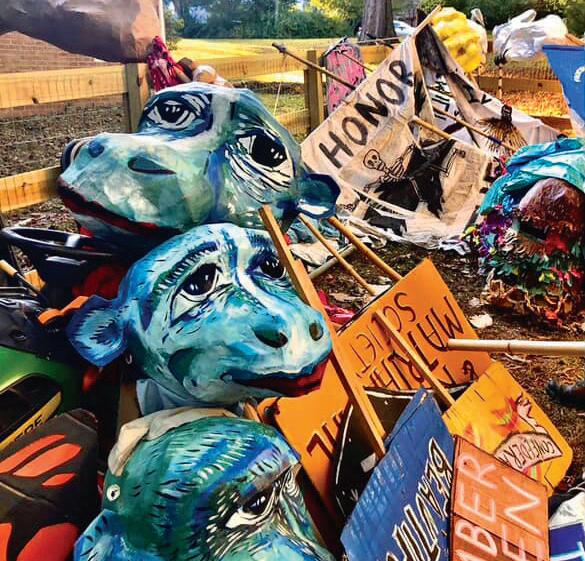



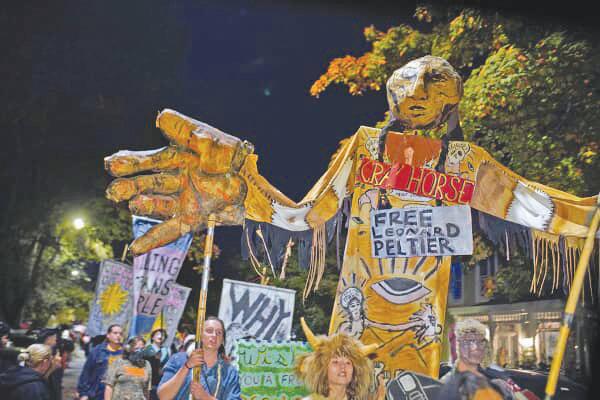














DEVYNN
ALSTON
Contributing Writer
Richmond has a lot of Halloween traditions; spooky movies at the Byrd, Terror on the Farm and P’s and Q’s Annual Spooktacular — but perhaps the most iconic is the All the Saints Theater Company’s annual Richmond Halloween Parade. They will celebrate their 20th anniversary this year.
All the Saints Theater is a politicallycharged group that uses papier mache masks as a form of activism and community building. Each year, Lil Lamberta, the director and master puppeteer, organizes a team of artists, activists and volunteers to help build their pieces, according to their website.
All the Saints does a “funeral march” themed around a relevant political topic, which extends to the puppet and float designs. This year’s theme is “A Funeral March for the American Dream.”
With executive overreach by the Trump Administration, voting rights and birthright citizenship in peril and a
surge in immigration enforcement actions across the country, many Richmonders are expected to turn out and mourn at the funeral.
Marches in years past lamented the genocide in Gaza and the overturning of Roe v. Wade by the Supreme Court.
The parade’s theme gets selected based on current events, social ecology and social justice issues the puppeteers feel are immediate concerns, Lamberta stated in an email.
The puppets follow pageant-style puppetry throughout the parade, meaning they play out a story in motion with a beginning, middle and end, Lamberta stated.
Anyone can participate in the parade — as long as they wear a costume. Attendees can hold puppets, volunteer to build one or just stand and watch.
The parade is designed to be accessible to all, regardless of age. The route is less than a mile, starting at Monroe Park and ending at Pleasant’s Park in Oregon Hill, where the marching band riffs back and forth.
Musicians are welcome to join the parade’s marching band, which is made up of a mix of local artists, members of VCU’s Peppas, music students and plain old music lovers. No prior knowledge is required, as the music is taught to attendees right before the parade by John Hulley, a member of the Richmond mainstay band No BS! Brass.
There will also be a pre-Halloween fundraising extravaganza, giving people a sneak peek at the puppets. It will be at Studio Two Three and begin at 7 p.m. on Oct. 30.
“Our online fundraiser is moving slowly this year and we totally honor that the capitalist death cult has put us in an uncertain place with housing, finances, healthcare, basic right to exist and migrate, being indigenous and/or a brown person, it IS in fact ridiculous to use your hard earned dollars to support a puppet parade,” the company stated in an Instagram post. “However, we artists coexist in the same time and place and we use what we got to do this parade every year because we love it, we can’t live without making art and purging this discourse, rhetoric, ideas,





‘Funeral March for the American Dream: Puppeteers prepare for 20th Richmond Halloween Parade
puppet flotillas and satirical subversive radical puppetry from our minds and body.” Goad Gatsby, a journalist for RVAmag who has covered the parade for the past three years, said it is a “walker’s paradise.” Gatsby uses the parade as a chance to see old friends and meet new ones. He also participates in the event himself, dressing up as the “white trash can.”
“My character, the white trash can, where I give out candy and incorrectly guess people’s costumes,” Gatsby said.
The purpose of this event is to build community by bringing together a large group of people and “keep the Halloween magic alive,” according to the official parade Facebook page.
“I love the amount of people it brings out, and the amount of community that’s involved, we get lots of trick-or-treaters,” Oregon Hill resident Emily Czachor said. Richmonders looking to catch the parade should hang out on Laurel Street between Monroe Park and Oregon Hill at 7 p.m. on Halloween.
A night of frights and delights at RVA’s Spooky Square Dance
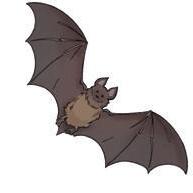










SAANVI VOOTLA Contributing Writer
Richmonders put on their best costumes and dancing shoes for RVA Square Dance’s Halloween celebration on Oct. 25.Attendees kicked up their heels a nd embraced the rhythm to celebrate the spooky season through movement and community.
Monthly hoedowns held by RVA Square Dance travel throughout the bustling streets of Downtown Richmond. Having experience in dance is not something to worry about at RVA Square Dance. As long as you have the spirit and guts to indulge in the art of dance and have fun. Training sessions are held before the dance for newcomers.
Some attendees wore a green, laminated button to indicate they are seasoned dancers, gracefully guiding newcomers across the floor to feel the rhythm of the night.
The clicking of boots on the wood floors harmonized with folk music and laughter. Strings attached, hands linked and feet wove across the floor, matching the strums of the live bluegrass band, Garden Variety String Band.
“I like that our band was allowed to perform at an event like this,” Wyatt Peake, the band’s fiddle player said. “We usually perform old-time bluegrass music, so it is a little different because these songs are longer, but I kind of just get in a trance and play.”
Longtime dancer Adrienne Robertson is among the organizers who helped bring this event to life.
“I have been dancing for 30 years, taking classes since I was a kid,” Robertson said. “I wasn’t super into being a ballerina, but I was always looking for opportunities to just get out there and move.”
RVA Square Dance events are designed to be as inclusive as possible, with guidance available for anyone ready to join.
Continued on next page












The spooky square dance blends Richmond’s creative spirit with the tradition of communal movement.
“My favorite style of dance at the moment is square,” Robertson said. “Watching my kid grow up enjoying the music, dancing freely and being openly invited into that community makes it special.”
Becoming an experienced dancer takes time, and those who wore the green button at the event took that time like Becca Hoover.
“I’ve probably been square dancing for about a year now and at first I was really shy so I struggled with connecting with others,” Hoover said. “Attending these events regularly allowed me to open up, meet new people and have fun with strangers.”








Dance has its origins in various cultures and can bring people across those borders.
“I’m French, so it’s [square dancing] not something I grew up doing, but it’s really fun and I love that you can keep changing partners so it gets less awkward and I was able to make new friends,” participant Julie Grosche said.
The evening concluded with dancers of all backgrounds sharing the floor, their movements reflecting the unity and energy that have made square dancing a g rowing tradition.
Whether you are just looking for a fun time or to be captured in the world of dance, check out RVASquareDance on Instagram for information on future events.


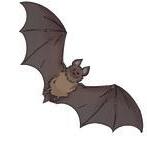


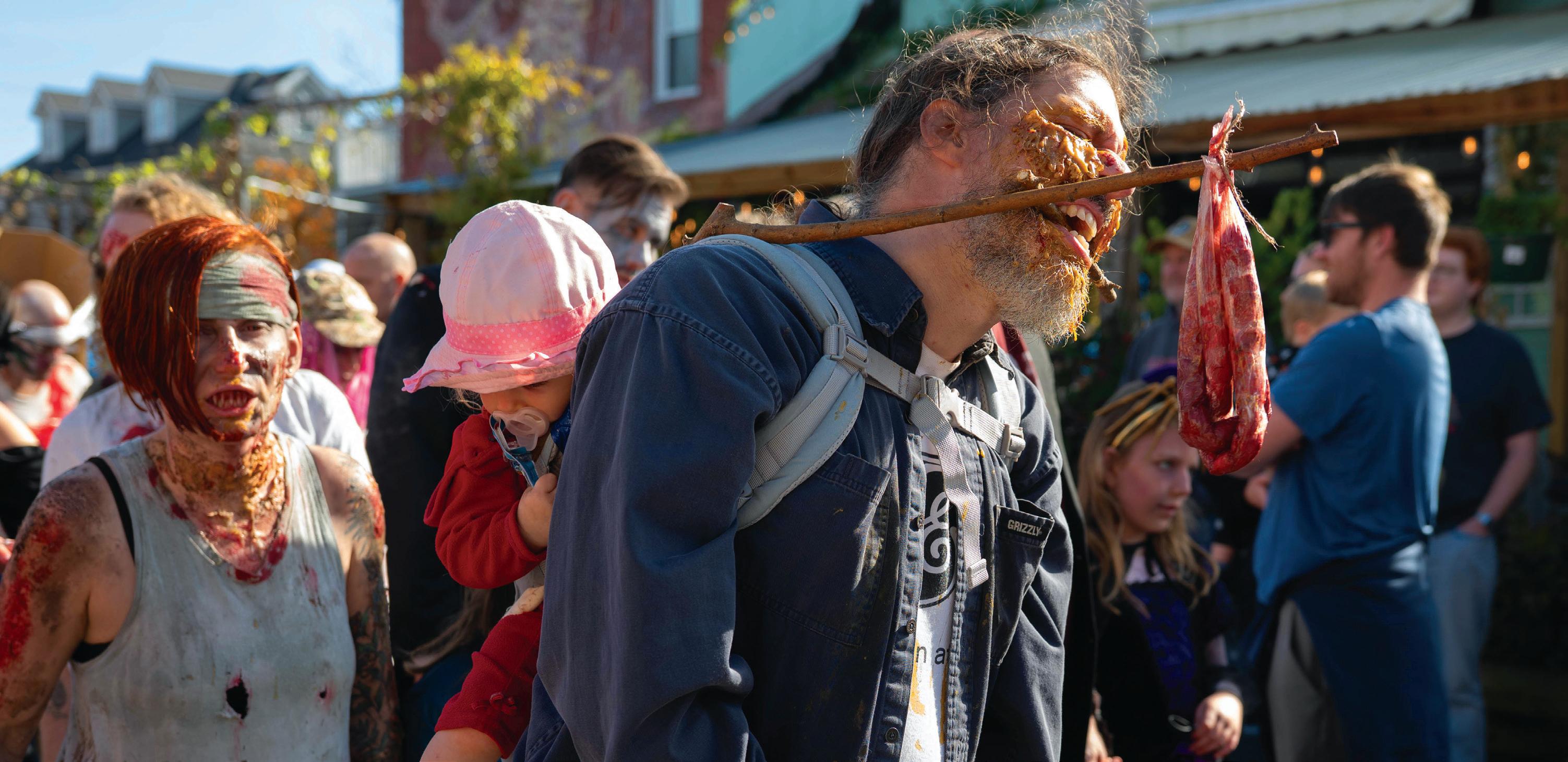
Richmond Zombie Walk still invades Carytown 20 years later
CORA PERKINS
Assistant Spectrum Editor
Zombies swarm the streets, crawling and limping down as blood seeps from their wounds and they try to keep their eyes in their heads. Hungry for brains, these creatures teeter through Carytown, leaving screams and horror in their wake.
This is not the apocalypse — it is the Richmond Zombie Walk, which returned for its 20th anniversary on Oct. 25. Stretching from Byrd Park to Carytown, hundreds of participants dress up as zombies creep along and even more spectators watch from cafes, stores and restaurants.
The event began in 2005 and is now organized by Anthony M eñez and Josh Bishop, who have turned it into an annual outing.
The walk has grown to new levels since its creation 20 years ago, according to Meñez.
“I think at our height, we probably had almost 700 participants,” Meñez said. “You know, it’s come to the point where we have to zombie walk in a single file, at least for the first couple of blocks, because there are so many people lining both sides of the sidewalk, like taking pictures or just, you know, they want to see.”
The event brings droves of spectators to witness the hordes of zombies hobbling down the road, and with it, their business.
“Carytown didn’t really like us until they realized that people were coming just to see us, and so our attendance just kind of increased foot traffic by a lot,” Meñez said. “They warmed up to the idea, and now they fully embrace us; they can’t wait for us to be there because it’s usually a pretty packed street.”
The Richmond Zombie Walk is officially integrated into “Scarytown,” a day of Halloween themed events in Carytown, by the Carytown Merchants Association, Meñez said.
Phillip Siedow, a cosplayer who attended the Zombie Walk, said the event gives him opportunities to be creative.
“I like expressing my creativity and what zombie variations of characters I can do,” Siedow said. “I just went from different variations of characters I usually cosplay in their human form, then I’ll just go for a zombie form.”
The Richmond Zombie Walk began when founder Roger Barr organized a flash mob of zombies at Short Pump Mall in inspiration of films like “Dawn of the Dead.”
However, the day did not go as planned.
“So the day that we met in a park to kind of get organized and put on our zombie blood and makeup and everything, showed up,” Barr said. “[The authorities] told us that if we showed up at Short Pump Mall, we’d be arrested.”
Barr and the rest of the near hundred zombies had to decide where to go.
“The entire horde of zombies, pretty much unanimously, we voted for Carytown, the rest is kind of history from there,” Barr said.
The crowd went all through Carytown, and then continued onto VCU, moving from music festivals to weddings, and ultimately ending at the Cabell Library.
“The looks on people’s faces as we walked through the library, it was just absolute delightful, bewilderment,” Barr said. “That's definitely one of my favorite memories from the original walk.”
Twenty years later, Barr returned to walk for the first time since the event’s creation.
“I always had said I told [Anthony] and Josh all those years ago, if this thing makes it to 20 years, I will absolutely be back to walk for that anniversary,” Barr said. “So I had to fulfill that promise.”
The event has grown incredibly, according to Barr.
“But it’s just become this amazing, weird Halloween family event and that everyone gets to put their own little spin on zombies, whether it’s pop culture or whatever,” Barr said.
Barr hopes that the Zombie Walk will continue for years to come.
“I hope it keeps on going long long after I'm gone and an actual zombie,” Barr said. All proceeds from the event this year will benefit suicide awareness and prevention, a cause near and dear to Barr’s heart.












BOO!
Features
RVA Spotlight
It’s almost peak spooky season! Celebrate with one of Richmond’s Eerie Canal Tours, this weekend only. The “hauntingly narrated” boat tours start on Halloween, and tickets are on sale for $6 on Venture Richmond’s website.

Richmond’s food deserts are not a coincidence How local groups are working to help those in need
MOLLY MANNING
News Editor
Antonio Hicks stood at the corner of Main and Meadow Streets in the Fan neighborhood and pointed up and down the road, where he remembers grocery stores like Community Pride and Safeway once were.
Hicks has lived in Richmond all his life, and now, he said he takes the bus to the Kroger in Carytown, about a 15-minute bus ride or a half-hour walk.
“I grew up around here in the 70s. So this is a little different compared to now,” Hicks said. “And not really nothing new. It’s not enough opportunity to get groceries out here. We’re in decline.”
Hicks said the streets used to be home to Boys and Girls Clubs, grocery stores and fruit trees, but the area’s redevelopment pushed existing businesses and residents out.
“We ain’t never had no problem getting no groceries around here,” Hicks said. “When they got around here, they said it’s impossible these people built like that. Call it the Wall Street. Look at the history they trying to erase and why they try to erase it. You know we made some beautiful stuff right here.”
HISTORICAL DISINVESTMENT LED TO FOOD DESERTS
In post-Civil War Richmond, the Jackson Ward neighborhood became known as “Black Wall Street.” Second Street served as a hub for Black-owned businesses like insurance companies,
theaters and banks, according to the National Parks Service.
The neighborhood was “redlined” in the 1930s because of its racial makeup and began to decline. The city bulldozed the neighborhood and displaced its residents in the 1940s for the construction of what is now I-95 in a “slum clearance” project that effectively split the neighborhood into two, isolating what became Gilpin from Jackson Ward, according to the New York Times.
Spatial inequality today is a reflection of redlining — formerly redlined neighborhoods are often disinvested in by cities and targeted to be razed for the construction of interstates, urban renewal projects or gentrification, said Robert Nelson, director of the Digital Scholarship Lab at the University of Richmond.
UR’s Digital Scholarship Lab created “Mapping Inequality,” an online collection of redlining maps across the United States.
Redlining was a process introduced in the late 1930s after the Great Depression which created “security maps” aimed at determining the security of neighborhoods for lenders of home loans. Redlining limited communities’ access to mortgages and prevented them from building wealth through homeownership.
Food deserts are a form of discrimination, and their maps often reflect historical redlining maps, Nelson said. They are areas lacking access to fresh foods, like fruits and vegetables, and supermarkets.
Researchers like Anika Hines, VCU associate professor of health policy, have worked to link racial disparities and food access in Richmond.
In Richmond, African Americans are about 10% more likely to be food insecure compared to their white counterparts nationwide, according to “Structural Racism and the Food Environment,” Hines’s research with The Valentine.
Hines said racial residential segregation is a disinvestment from an entire community.
“To be poor and white and to be poor and Black are not the same thing because you have these clustering of impoverished folks,” Hines said. “That’s kind of some of the residuals of redlining that we still see today. That has kind of created the housing infrastructure, created the community structures, the neighborhood structures, that link with it all these other factors related to social drivers of health.”
Hines said home values are tied to taxes that fund schools in an area, but also impact business landscapes.
“A chain of grocery stores might have categorizations of stores that might have higher quality foods and lower prices versus lower quality foods at higher prices,” Hines said. “That is also so tied to the communities that they serve.”
Neighborhoods considered “food deserts” are often “food swamps” as well, meaning they lack supermarkets and have high concentrations of fast food restaurants, Hines said.
“You’re expecting someone, instead of going to McDonald’s, to take three buses across town to get to the supermarket, to then lug a couple of bags of groceries onto the bus [and] bring it back to prepare,” Hines said. “It becomes a great burden for an individual to take on the task of trying to navigate these structural barriers that
won't allow them the easiest way to do the right thing.”
THE CITY IS WORKING TO ADDRESS FOOD INSECURITY
Hines referred to The Market at 25th as a response to a food desert in Richmond’s East End, which was historically redlined. She pointed to high eviction rates and a lack of affordable housing as an effect of the city’s steep history of racist housing policies.
“I think it’s on all of us, really, to think about the ways that we are allowing our fellow citizens, our neighbors, to not have access to the things that they need to survive,” Hines said. “Where you live should not have bearings on how long your life will be or what options you have to do something that is as fundamental as eating food.”
Ensuring access to transportation options for traveling to supermarkets, supporting urban farmers and ensuring nutritional lunches in schools are all ways the local government or community can work to address food insecurity, Hines said.
The City of Richmond first included food access in its Master Plan in 2020, featuring the Richmond Food Justice Alliance’s work in driving policy to expand access to healthy food. The Alliance is a resident-led organization created in 2017 to advocate for food access in historically disenfranchised neighborhoods.
Richmond Grows Gardens, one initiative from the Master Plan, sponsors several community gardens throughout the city aimed at supporting sustainability and food access for residents.
VCU’s Ram Pantry also works to


community and university partners by providing degreeseeking students with things like produce, household goods and hygiene items.
RVA
COMMUNITY FRIDGES FIGHTS FOOD INSECURITY WITH MUTUAL AID
About a year after Taylor Scott graduated from VCU in 2020, she had an excess of tomatoes grown on her hydroponic farm stand, Patience. On the phone, a friend said she should bring them to her local community fridge.
When Scott looked up the nearest community fridge, she realized Virginia had none. Her birthday fell on Thanksgiving that year, and she decided her birthday and Thanksgiving gift to the city would be a community fridge.
Since RVA Community Fridges’ first fridge opened in Church Hill, they have created 15 more locations throughout the city.
Volunteers head to local farms like Shalom Farms and Shine Farms to pick up produce and stock the fridges almost every day.
“We are by the community and for the community,” Scott said.
Matchbox Mutual Aid is RVA Community Fridges’ kitchen, where they hold weekly “community cook days” and make 200 meals to put in the fridges, Scott said. They also fund home cooks, who can buy supplies or make meals at home to drop off, as well as community shoppers.
“A lot of people, they’re trying to just find a place where they can grab something and go,” Scott said. “And it’s very, very helpful when they’re like, ‘Okay, I know this fridge is 5 minutes away versus going to a grocery store that’s 25

minutes away. I can get this.’”
Aside from the nutritional benefits of fresh meals and produce, Scott said the fridges allow better knowledge of where food is coming from. They also have pantries so community members can access dried goods and products like toiletries or baby items.
Many of them are located in historically redlined areas as well, according to Scott. She points to physical ability, transportation and time restrictions as barriers for many Richmonders in accessing established grocery stores; the community fridges aim to alleviate these barriers in food access.
“It kind of gives you a place to actually get the resources you need, but also feel like you’re not left out.” Scott said. “We’re not pushing people away in any aspect, you know. We try to make them physically accessible as well as timely accessible, which is why we try to keep them open 24/7.”
Scott said they are considering adding community lunch days, to supplement lunch times and days they do not have drops for supplies in the fridges amid current cuts to SNAP benefits.
Richmond Food Not Bombs is another local volunteer-based branch of the global movement working to share free vegan and vegetarian meals as a protest against war and poverty.
The Richmond chapter was created in 1993 and has served over 50,000 meals, according to their website. They also operate out of the Matchbox Mutual Aid kitchen on North Avenue.
MAD RVA ENCOURAGES THE COMMUNITY ‘TAKE WHAT YOU NEED, GIVE WHAT YOU CAN’
Mutual Aid Distribution RVA runs a free grocery and resource store in Richmond’s Northside. The Meadowbridge Community Market is open every Saturday for community members to access food and resources without having to provide an ID, proof of income or any other personal information.
Alex Feygin, a MAD RVA collective member, said the organization began just before the COVID-19 pandemic and



has evolved since then. He said it was a “particularly brutal” winter, and after the cold shelters in the city shut down, an unofficial group formed to help other community members through distributing hot beverages and other supplies.
During the pandemic, they shifted to providing resources from restaurants and businesses shutting down to those in need. After they determined their capacity for distribution, Feygin said the collective rented a warehouse downtown.
The current Meadowbridge Community Market is what they envisioned creating — a location in an area that historically lacks food access is the “ultimate way to do full resource distribution,” Feygin said.
MAD RVA is currently campaigning to buy the space they are leasing from a former collective member for the Meadowbridge Community Market.
There was an internal debate between the north and south sides of the city when determining the market’s location, Feygin said. They decided a location on the Northside was more accessible by transit and also had more properties available for purchase.
At the community market, the team spends part of the week gathering donations from local farms and other organizations; they also purchase bulk goods from Feed More weekly. Feed More is a central Virginia-based nonprofit created in 2005 as a combined effort of Meals on Wheels and the Central Virginia Food Bank.
Feygin said he wants to see the local government reduce the limitations put on resource distribution. During the January water crisis, he said the City of Richmond
limited the number of cases of water people could take, police asked some residents for IDs and distribution was only happening in certain locations.
“We were following our model of no limits on distribution, we distributed something like 10,000 bottles, whereas the Richmond PD only distributed something like 800 bottles,” Feygin said. “If you have an abundance of something and it’s something people need, it should be with the people rather than stored and siloed.”
MAD RVA stocks the community market on Fridays, and the free store is open on Saturdays from 10 a.m. to 4 p.m. Their policy is to “take what you need and give what you can,” Feygin said.
“Folks need to eat regardless of their immigration status, regardless of their housing status, regardless of their employment,” Feygin said. “We tend to take people at their word and that works



Opinions We have entered the misinformation age
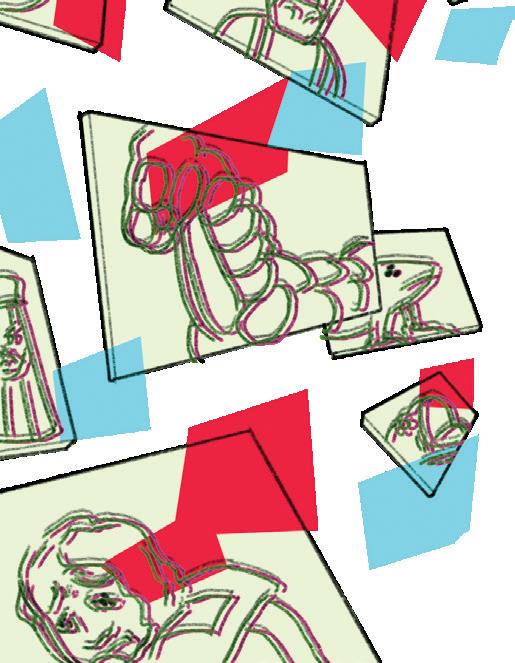
HENRY JOBE Contributing Writer
In the mid-20th century, rapid improvements and growing access to technology resulted in the term “Information Age.”
This historical period was characterized by access to incredible quantities of knowledge. Anyone from almost anywhere in the world could access information on the internet. This accessibility only grew as more data was uploaded, and technologies like cell phones and personal computers became cheaper and more available.
We have reached the definitive end of the Information Age.
With the rise of misinformation, heightened by social media bots and generative artificial intelligence programs like the newly released Sora 2, it’s becoming increasingly hard to believe anything you see on the internet.
There has always been a level of awareness required to navigate the internet effectively. It isn’t particularly difficult to create a mildly convincing Photoshop or improperly edit information on opensource websites like Wikipedia. However, these methods require skills with editing programs or the ability to sneak past
attentive moderation. Not only are AI programs free and accessible, they are also incredibly easy to use — and abuse.
These programs have improved exponentially in such a short time so that many of the tells that could be relied upon to spot fake images — too many fingers or inconsistent backgrounds, for example — no longer work. It has become increasingly difficult to determine whether videos and images are AI-generated or not without careful inspection.
Just look at websites like Facebook or X, which have become flooded with provocative videos and photos that are passed off as real.
The VCU community has already gotten a taste of the issues AI social media posts create. In October 2024, VCU’s Board of Visitors member Rooz Dadabhoy posted a fake image of a girl in a lifejacket holding a puppy during a hurricane with a politicallycharged and aggressive caption.
Using fake images or videos to make a political statement is grossly irresponsible and has become concerningly common.
Several government agencies, including the Department of Homeland Security, have posted numerous AI-generated images and videos online. These come across as exceptionally sinister, presenting
entirely fictionalized videos of fabricated events as facts.
Video evidence is also an area of concern. For the longest time, recording devices such as dashcams and security cameras served as irrefutable evidence in court, unmistakable proof of who committed a crime. But AI has become very good at mimicking security camera footage, and unless courts can consistently verify video evidence as legitimate, it will likely lose much of its power.
With easy access to this new technology, what is to stop someone from modifying security camera footage to replace a burglar with someone else, or creating entirely new dashcam footage that frames the perpetrator as faultless?
All of these elements together have led to a necessary rise in distrust of what we see online, as the internet is flooded with false information, whether textual or visual.
With tech companies like Google and Meta uninterested in stopping the flood, it’s up to each of us to navigate the flow and stay properly informed in the Misinformation Age we find ourselves in.
Two methods can help protect you from unknowingly consuming falsified information.
First, find news and social media
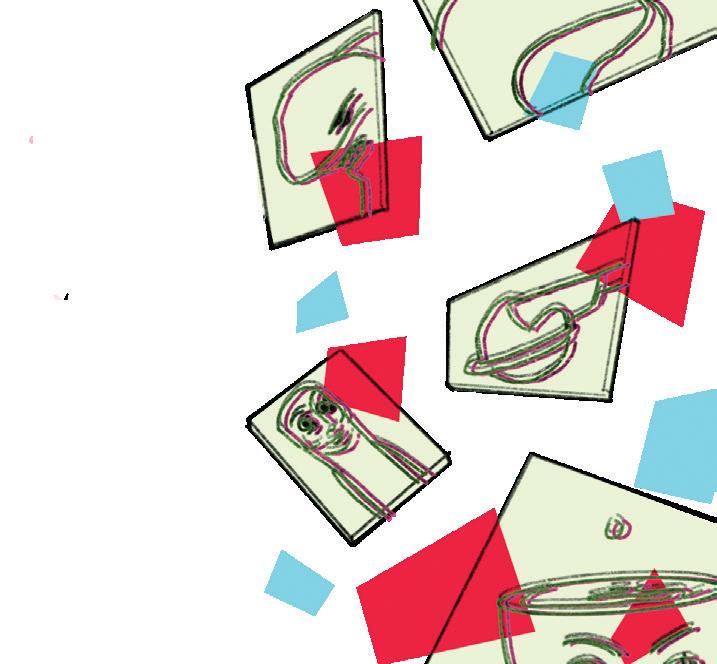
accounts that you trust to not use AI — even better if they have staunchly refused to. While this won’t prevent you from seeing AI-generated posts entirely, you will have confidence that the posts from these accounts are real.
Second, improve your own ability to recognize AI posts — there are still ways to spot them if you know what to look for. Instagram accounts such as @showtoolsAI have been essential in keeping me up to date on what to look for. While many of the older AI glitches aren’t as common these days, there are still ways to tell, and developing that skillset will only become more important as Generative AI gets harder to parse.
Most importantly, remember nothing exists in a vacuum — leaving a like on an AI video of raccoons bouncing on a trampoline or Stephen Hawking hitting “sick” tricks at the skatepark tells botfarms and corporations there is a market for this content. Using or viewing AI content helps it improve, and giving it attention is a reward.
Use this as an opportunity to improve your media literacy — your future self will thank you.

Leftist virtue signalling is getting us nowhere
MAYA SUNDERRAJ
Assistant Opinions Editor
Virtue signalling is a term that holds a lot of weight in today’s political climate, depending on who is speaking and listening. For some, it can be beneficial to understanding a person’s ideologies or sharing one’s own. For others, it is seen as a way to present an image of empathy and activism, a way to boost one’s reputation without having to do any actual work.
I lie somewhere in the middle of these profoundly different philosophies and believe that virtue signalling can be good only if it is backed by substantive action. My major issue is more social than theoretical. Currently, the aesthetic of virtue and empathy is prized over the actual trait itself. The issue itself is nonpartisan.
Still, people — leftists specifically — have a trend of becoming bogged down by the puritan values they claim to be eschewing. Attention is being diverted from real issues at hand, such as the United States’ penchant for political violence and the Trump administration’s autocratic tendencies.
For Maine Democratic Senate candidate Graham Platner, valuable time that might have been spent discussing policy and the current state of the federal government has instead been sacrificed to an apology tour for a tattoo of his that allegedly resembles Nazi iconography.
The tattoo, which he got while deployed overseas with the Marines in 2007, shares a likeness with the Nazi “Totenkopf” or “death’s head” skull.

Platner has denied all allegations that he is aligned with Nazi ideology.
“I absolutely would not have gone through life having this on my chest if I knew,” Platner said.
With the Nazi allegations comes additional criticism for previous inflammatory, homophobic and overall ignorant Reddit posts — comments, using “f*****” and “gay” as low-brow insults, calling police “bastards” and perpetuating false stereotypes about other races.
Yikes.
Still, I think it is worth noting Platner has fully acknowledged and apologized for his idiotic and reprehensible actions.
“Even though I thought I was openminded, there were elements to [the LGBT+ community’s] existence that I had been entirely unaware of,” Platner said. “That was when I began to really take far more seriously the damaging nature of language,” Platner said in an interview with the Advocate.
Platner further described what he said as “indefensible.”
I would consider that an apt description.
This stuff needs to be talked about. How else are we supposed to hold our political candidates accountable? Still, the lengths taken and amount of coverage surrounding Platner’s controversy prove to be a doubleedged sword.
Platner’s primary is less than a year away. Midterms are about one year away. This is the finish line. Candidates should be pushing their policy and visions for their term at all costs — not giving interviews about their social media history.

It’s frustrating, but when does the act of virtue signalling overtake bringing virtue to positions of power through policy? I fear we are shooting ourselves in the foot.
What would the ideal path forward be for someone with a past like Platner’s? What else can he do to be redeemed in the eyes of the American people?
When people like Platner — who have acknowledged their mistakes, apologized and are looking to change — are met with antagonism, it sends the message that redemption is near-impossible.
If that is the case, how is the United States of America, a country oh-so divided, supposed to heal and unite?
When we — as both the media and the people — cannot let go of past mistakes, a never-forgive, never-forget mindset is
introduced that harms everyone more than it helps. Why does the past receive more focus than what threatens today and onward?
And when virtue signaling becomes the foundation of political action, voters grow distracted from the policy that actually matters.
Political scandals occur often, but more importantly, international humanitarian law is broken and acts of political violence occur daily.
While it’s important to stay aware of past events, there is so much today and tomorrow that must be talked about. Remaining vigilant and critical of candidates and elected officials does not mean we should be beating dead horses.


Laziness is ruining Halloween

Cady Heron from “Mean Girls” famously said, “Halloween is the one night a year when a girl can dress up… and no other girls can say anything about it.” I, however, have some things to say about it.
First off, the costumes being referenced were barely costumes. Regina had on bunny ears, fuzzy wrist cuffs, a white corset and black shorts. Karen, while not in a corset, relied solely on a headband to make her grey dress into a mouse “costume.”
Cady, on the other hand, went all out with the zombie bride theme. From what


I’ve seen, most college students seem to lean towards the Regina and Karen end of the Halloween costume spectrum, rather than Cady’s.
It’s fine if you don’t want to be a scary zombie bride on Halloween, but at least dress as something out of the ordinary.
Don’t think that I am letting the guy’s costumes slide either. At least with girls, there is a headband, a corset — something. I have seen some students dress in black t-shirts with black jeans and say they are “Venom.”
Men being so incredibly nonchalant when it comes to Halloween is not in the slightest bit cool — it’s just pathetic.

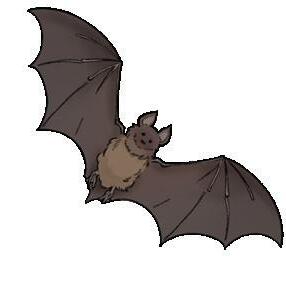
Generally speaking, college students’ costumes suck. Where is the creativity? Where is the innovation? Where is the — hopefully — fake blood?
If I have to ask what you are, and you say, “I’m a mouse, duh,” I think I may just scream. In fact, dress up as someone from “Scream” — that would be better than falling for the corset-mania that seems to have taken over Halloween.
There are so many cooler, cheaper and simply better costume pieces than corsets and poor-quality headbands.
I think we want our costumes to be liked out of a fear of being made fun of. A
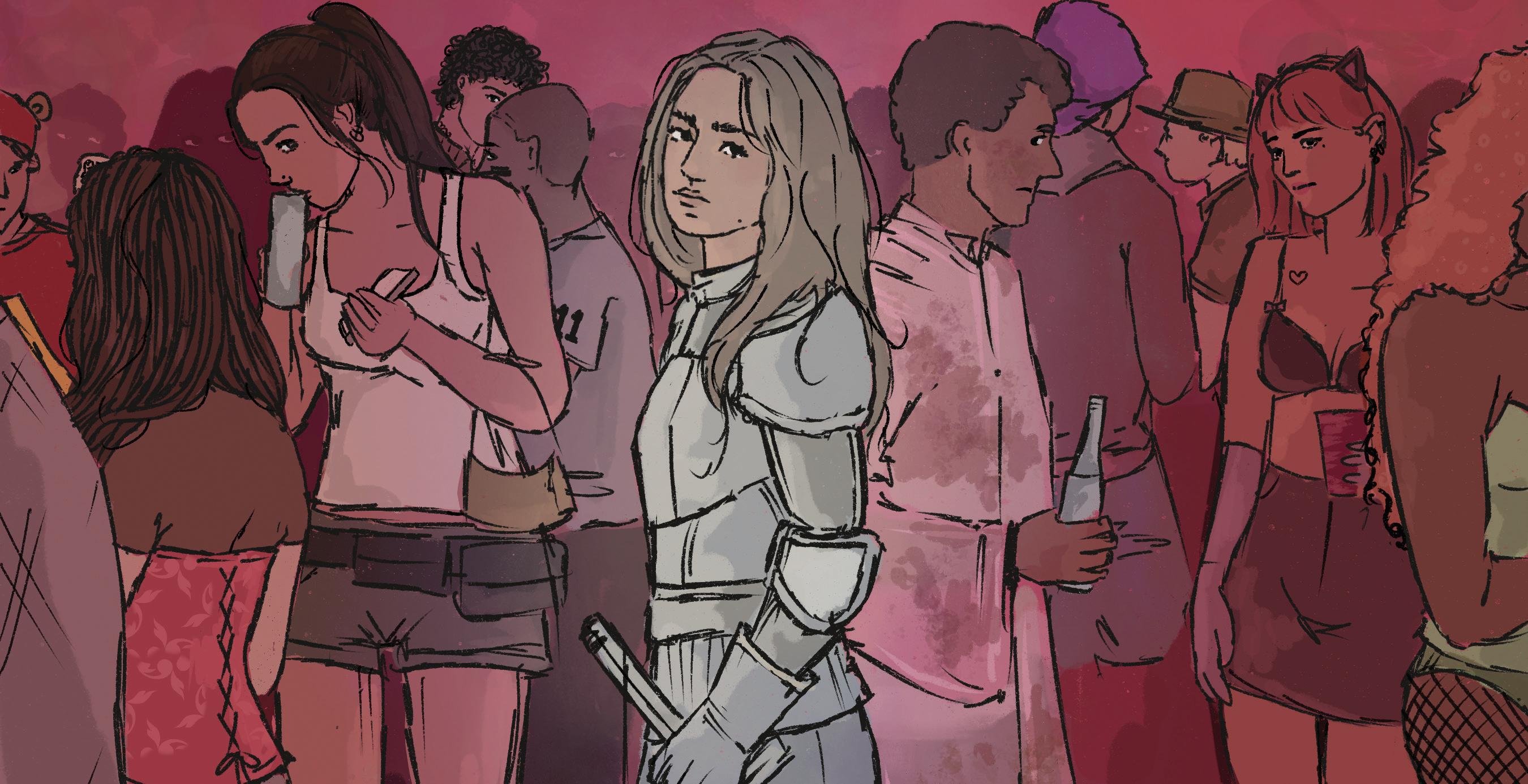


lot of who we are comes from how we are perceived. Do others think we are pretty? Do we seem smart, kind or silly?
Even if you don’t post your outfit yourself, you’re probably photobombing a post somewhere on the internet, and that is kind of nerve-wracking. So why not be comfortable in a (hopefully fake) bloody costume? Why choose to be uncomfortable, cold and unable to breathe for the sake of a current beauty standard?
You don’t need to go out and buy a zombie bride dress to have a good costume. You just need some time, blood and a sprinkle of creativity to create a unique look. Using pieces from your closet isn’t inherently a bad thing — just don’t be lazy about it. In fact, it is better for you and the environment if you don’t buy something for one-time use. DIY Halloween costumes are some of the most compelling and eyecatching — all it takes is a little effort to make something truly extraordinary.
This Halloween, please break free from the basic corset craze. Be creative and have fun with pieces you already own. Make something unique and — dare I say — quirky. If you don’t feel slightly stupid on Halloween, you probably are not doing it right.

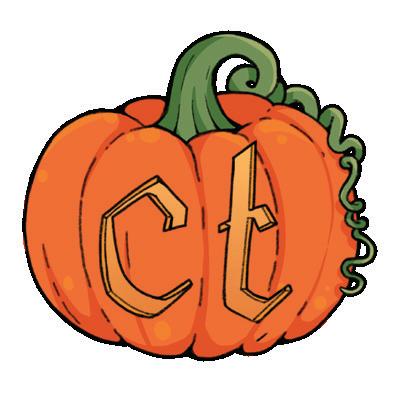
Humor
Joke of the week
" Helvetica and Times New Roman walk into a bar. 'Get out of here!' shouts the bartender. 'We don’t serve your type.'” — Reader's Digest

Treats for your tricky questions

LAUREN PRATTIS
Contributing Writer
Fall is finally here — the leaves are changing colors, the weather is getting cooler and Dr. Times is back.
The CT staff submitted questions about how to navigate the changing leaves and everything that comes along with the spookiest season of all.
Dear Dr. Times,
How best should I dress for the hot and cold weather of Richmond in October?
Sincerely,
Putting the “sweat” in “sweater”
Dear Reader,
Richmond’s climate is a force to be reckoned with, and I completely understand your struggle. I used to leave for my morning commute in a nice fall outfit only to be sweating buckets by lunchtime. I recently invented the perfect fix — electronic cardigans. This cutting-edge
Once it reaches noon and the crisp fall air turns into a hot and humid disaster, switch on the AC. This will let you keep up with fall styles while staying as cool as a cucumber.
The only issues reported during product testing were first-degree burns, hair being singed off and the product bursting into flames when it made contact with even the slightest droplet of water.
Stay warm — or cool, Dr. Times
Dear Dr. Times,
My roommate moved out because our apartment is haunted. How do I get the ghost to start paying rent to make up for it?
Sincerely,
Haunted and broke
Dear Reader,
This is more common than you think. Richmond is known for its ghost tours, but that does not mean the spirit should live in your humble abode for free.

The Ghostbusters are known for their beige jumpsuits and ghost-trap backpacks, but they also have a small claims division.
The Ghostbusters’ small claims division consists of a team of legal
They will give your new roommate an ultimatum — pay up or get zapped up into the containment chamber.
This usually works. You will get caught up on rent in no time.
Best of luck,
Dr. Times
Dear Dr. Times,
How many pumpkin spice lattes is too many? I’ve had seven every day since the end of August and I am starting to feel weird. Best, Stomachache survivor
Dear Reader,
This is a very common issue that I see in my practice around this time of the year. After years of much trial and error, I have the cure.
I recommend increasing your daily dosage from seven to nine pumpkin spice drinks. Although you have been drinking them multiple times a day for months, it is just not enough.
I also tell all my patients to buy pumpkin spice in bulk and keep it with them at all times. Adding it to all your meals — from your eggs at breakfast to your meatloaf at dinner — will help your body adapt.
return to your natural color around March. Happy fall, Dr. Times
Dear Dr. Times,
How do I make myself look younger so I can trick-or-treat as a 22-year-old? Anything helps, I want candy
Dear Reader,
Let me start by saying I respect your commitment to getting free treats. As we age, it becomes less socially acceptable for us to eat candy, so I respect you as a changemaker and a visionary.
You should invest in a shrink ray — they are expensive but worth it if you are fully committed to the cause.
You will shrink from your current adult height to the average height of a sevenyear-old. You will assimilate perfectly with the other neighborhood children and be able to get as much free candy as you desire. Like always, there will be some consequences. There is an 80% chance you will permanently remain the size of a seven-year-old. If you do end up growing, there is an 84% chance you will rise to double your adult height.





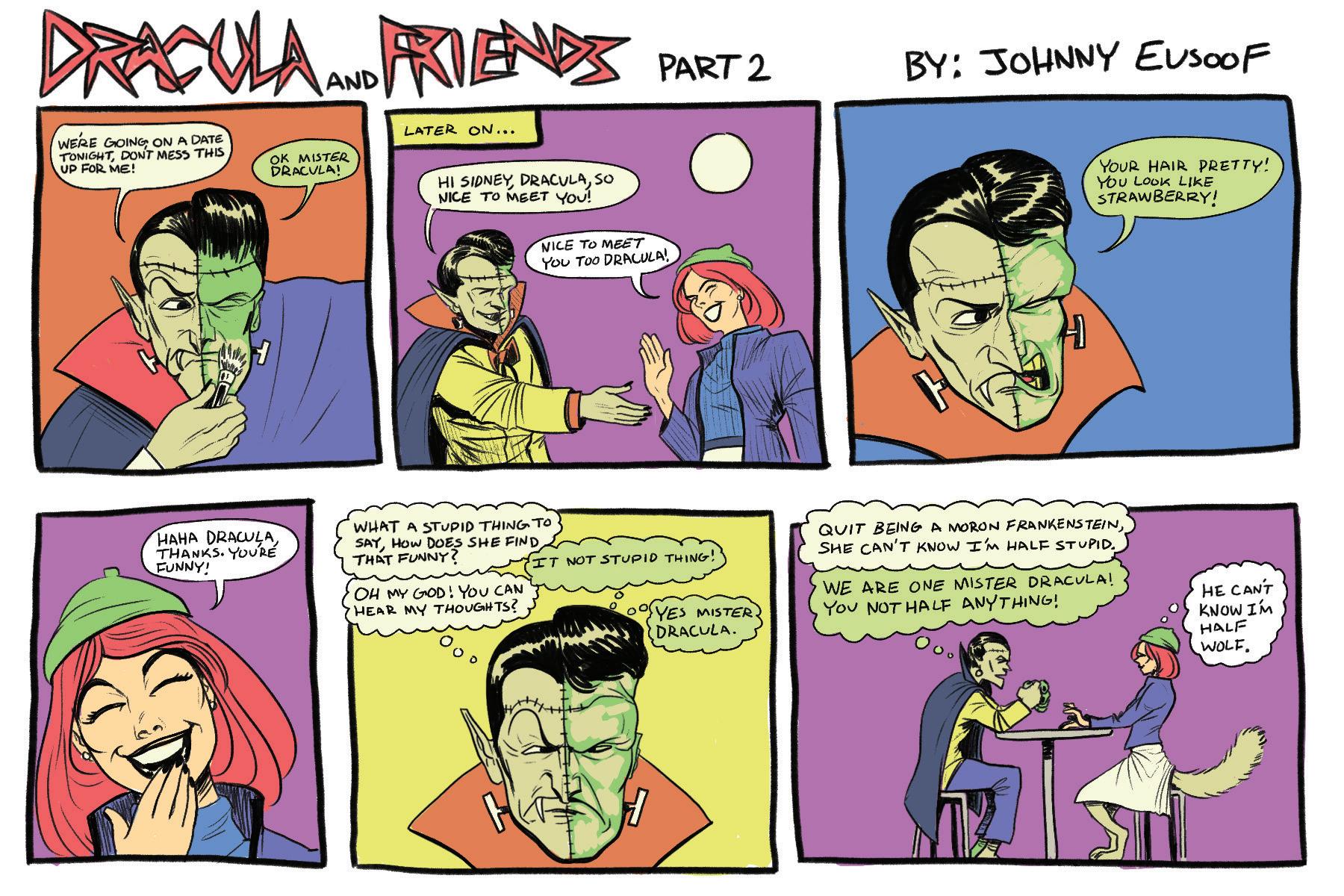








Puzzles
FOUR OF A KIND
By Adam Landau
Los Angeles Times Crossword Puzzle
FOUR OF A KIND
By Adam Landau
Edited by Patti Varol
7 More than a nibble 8 Like most recorded music from the 1990s 9 “Hate it!”
10Midwest capital 11 California Zephyr operator
measure
__ usted?”
son 94One who walks the walk
95Slightly off 96Tie-dyed quilt?
102Tagging symbols 103 Cones’counterparts 104Travel option 105Fall pile component 107Charcuterie meat 110 Bad habit 111 Big __: Red Sox nickname 114 Corleone played by Marlon Brando
117 Shooting star?
121Liberate
122Hunger (for)
123Abated
124Fantasy Football domain
125Caribbean vacation souvenir?
126Manchego sources
127Takes in a text
128__ nous DOWN
1 Bog down 2 Pomegranate seed 3 Waterfront laborer 4 “Gesundheit” prompt 5 Colorado hrs. 6 Lacking precipitation
12“Love it!” 13Slangy assent 14Like St. Paul’s Cathedral 15Itty-bitty bit 16Ob-gyns and ENTs 17Org. concerned with employee well-being 21Curl targets 23Estate document 24Texter’s qualifier 25Morning songbird 31U.K. honor for Naomie Harris 3260-Down, minus the champagne, for short 33Skewered Thai dishes
34Help a bad actor 35Luxury boat
37“We have the meats” chain 38Swears 39Didn’t throw away 40Lugosi of “Dracula”
41 Forever and a day
42 Ricochet, in billiards
43 Nautical speed units
45Majestic pronoun
50Knock softly on 51Deli bread
52Festive beverage
53Undergrad lecturer
54Surfing site for the 2024 Olympics
57Toyota minivan 58First Hebrew letters
60Bottomless brunch drinks
64[I’m a frog]
67“Ariel” voice actor Diggs
69Heart
71Like the Capitol building
72Confident poker action
73Curly-tailed guard dog
74Irish-themed casino on the Vegas Strip
76Heed the theater warning bell
78“Jersey __”: MTV reality show
79Stir up conflict
80Everglades wader
83Granola bar brand
84Basketball target 85 Chops down 88Trustworthy 92Around $8 million, for the Super Bowl 94ISPoption
95Gator follower
97Where the heart is, proverbially 98Myers-__ personality tests 99 A pop
adherent, perhaps
the birds?
meas.
claim
Bygone video app
Like good balsamic vinegar
Los Angeles Times Sunday Crossword Puzzle
Edited by Patti Varol
Edited by Patti Varol
By The Mepham Group
